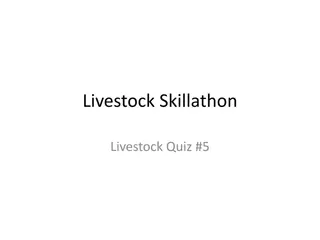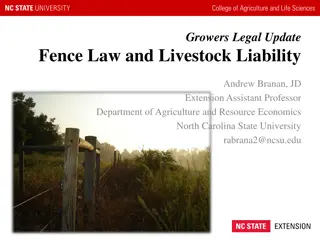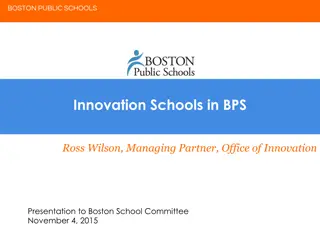Agistment of Livestock Training Package for Queensland State Schools
This training package provides guidance for Queensland state schools on agisting livestock, covering topics such as governance, livestock management, legislation, and ethics. It emphasizes the responsibility of schools in managing livestock, including educational and commercial arrangements, with a focus on compliance and best practices. Access the full document via the Department of Education Policy and Procedure Register for the most current version.
Download Presentation

Please find below an Image/Link to download the presentation.
The content on the website is provided AS IS for your information and personal use only. It may not be sold, licensed, or shared on other websites without obtaining consent from the author.If you encounter any issues during the download, it is possible that the publisher has removed the file from their server.
You are allowed to download the files provided on this website for personal or commercial use, subject to the condition that they are used lawfully. All files are the property of their respective owners.
The content on the website is provided AS IS for your information and personal use only. It may not be sold, licensed, or shared on other websites without obtaining consent from the author.
E N D
Presentation Transcript
Training package for Queensland state schools to support the Agistment of livestock Uncontrolled copy. Please refer to the Department of Education Policy and Procedure Register at https://ppr.qed.qld.gov.au/pp/agistment-of-livestock-procedure to ensure you have the most current version of this document.
Agistment of livestock Contents This package is to complement other employee induction programs 1. Introduction (slide 4) 2. Governance and accountability a) Asset management (slide 5) b) Revenue management (slide 6) c) Purchasing and procurement (slide 7) d) Gifts and benefits (slide 8) e) Donations (slide 9) f) Advertising and sponsorship (slide 10) g) Appropriate and ethical use of public resources (slide 11) h) Student protection (slide 12) i) School excursions (slide 13) Uncontrolled copy. Please refer to the Department of Education Policy and Procedure Register at https://ppr.qed.qld.gov.au/pp/agistment-of-livestock-procedure to ensure you have the most current version of this document.
Agistment of livestock Contents 3. Livestock a) Legislation (slide 14) b) Movement regulations (slides 15-16) c) Animal ethics (slide 17) d) Livestock records (slide 18) e) Agricultural science program agistment agreement (slide 19) Uncontrolled copy. Please refer to the Department of Education Policy and Procedure Register at https://ppr.qed.qld.gov.au/pp/agistment-of-livestock-procedure to ensure you have the most current version of this document.
Agistment of livestock Introduction Schools may agist livestock in a number of ways, including: agistment of privately owned livestock on school property (including livestock owned by school staff) for use in school educational programs or as a commercial arrangement. agistment of school livestock on non-school property. Schools are required to provide annual training on issues related to staff responsibilities for the agistment of livestock. The Agistment of livestock procedure outlines the administration processes and legislative requirements for the agistment of livestock by state schools. For detailed guidance refer to: https://ppr.qed.qld.gov.au/pp/agistment-of-livestock-procedure Uncontrolled copy. Please refer to the Department of Education Policy and Procedure Register at https://ppr.qed.qld.gov.au/pp/agistment-of-livestock-procedure to ensure you have the most current version of this document.
Agistment of livestock Asset management Assets are property, plant or equipment that are owned by the department and have a future economic value that can be measured reliably. Livestock owned by the school are considered to be assets. The sale of any department owned property must comply with the department s asset disposal methods. For detailed guidance refer to: https://ppr.qed.qld.gov.au/pp/assets-policy https://intranet.qed.qld.gov.au/Services/Finance/Assets/disposing- assets/Pages/asset-disposal-methods.aspx Uncontrolled copy. Please refer to the Department of Education Policy and Procedure Register at https://ppr.qed.qld.gov.au/pp/agistment-of-livestock-procedure to ensure you have the most current version of this document.
Agistment of livestock Revenue management Revenue is money or other resources that the department receives, applies and reports from: appropriations allocated within the State Budget fees and charges (including those associated with livestock agistment) voluntary financial contributions grants, sponsorships, donations, bequests and other contributions property income asset sales (including sale of livestock) insurance claims. For detailed guidance refer to: https://ppr.qed.qld.gov.au/pp/revenue-policy Uncontrolled copy. Please refer to the Department of Education Policy and Procedure Register at https://ppr.qed.qld.gov.au/pp/agistment-of-livestock-procedure to ensure you have the most current version of this document.
Agistment of livestock Purchasing and procurement The overarching government policy for the purchase of goods and services is the Queensland Procurement Policy (QPP). When purchasing goods and services or capital works associated with livestock (on behalf of the department), staff must comply with: the department s Purchasing and Procurement procedure, and the department s Purchasing and Procurement delegations. The procedure requires staff to follow the department s Purchasing and Procurement instructions that provide practical guidance on the application of the QPP, the procedure and the delegations. For advice regarding a purchasing or procurement activity, please contact the Procurement Services Branch (Email: procurement.capability@qed.qld.gov.au). For detailed guidance refer to: https://ppr.qed.qld.gov.au/pp/purchasing-and-procurement-procedure https://intranet.qed.qld.gov.au/Services/Finance/Forms/Documents/ProcurementD elegations.pdf Uncontrolled copy. Please refer to the Department of Education Policy and Procedure Register at https://ppr.qed.qld.gov.au/pp/agistment-of-livestock-procedure to ensure you have the most current version of this document.
Agistment of livestock Gifts and benefits Livestock or associated products (e.g. feed) may be gifted or donated to the school. All employees of the Queensland public service are required to comply with the Public Service Commission Directive No. 22/09 Gifts and Benefits and Gifts and Benefits Guideline if involved in the giving or receiving of gifts and benefits. Public service employees must not ask for, or encourage the giving of, any form of gift or benefit in connection with the performance of their official duties. When a gift/benefit is offered: 1. Consider whether the gift or benefit is appropriate to accept. 2. Consider why was the offer made and the public perception of accepting the offer. 3. Know that any offer of cash, or any items which are readily converted into cash, must be refused in all circumstances. 4. For any gift or benefit accepted which has a retail value of more than $150, a Gifts and Benefits Received Declaration must be completed. For detailed guidance refer to: https://ppr.qed.qld.gov.au/pp/gifts-and-benefits-procedure Uncontrolled copy. Please refer to the Department of Education Policy and Procedure Register at https://ppr.qed.qld.gov.au/pp/agistment-of-livestock-procedure to ensure you have the most current version of this document.
Agistment of livestock Donations When accepting donations, consider whether a conflict of interest could occur. Staff are to follow appropriate procedures for recording any donations made to the school. For detailed guidance refer to: https://intranet.qed.qld.gov.au/Services/Finance/Taxation/deductible-gift- recipient-funds/Pages/default.aspx https://ppr.qed.qld.gov.au/pp/donations-and-bequests-procedure Uncontrolled copy. Please refer to the Department of Education Policy and Procedure Register at https://ppr.qed.qld.gov.au/pp/agistment-of-livestock-procedure to ensure you have the most current version of this document.
Agistment of livestock Advertising and sponsorship Advertising and sponsorship activities must be undertaken in an open, transparent, fair and responsible manner. For livestock, this may be particularly relevant when agisting and showing animals. For detailed guidance refer to: https://ppr.qed.qld.gov.au/pp/advertising-procedure https://ppr.qed.qld.gov.au/pp/sponsorship-procedure Uncontrolled copy. Please refer to the Department of Education Policy and Procedure Register at https://ppr.qed.qld.gov.au/pp/agistment-of-livestock-procedure to ensure you have the most current version of this document.
Agistment of livestock Appropriate and ethical use of public resources All officers are accountable for the departmental resources that they use. Resource use must be publicly defensible and clearly provide improved outcomes for the department s customers or the State as a whole. For detailed guidance refer to: https://ppr.qed.qld.gov.au/pp/appropriate-and-ethical-use-of-public-resources-policy Uncontrolled copy. Please refer to the Department of Education Policy and Procedure Register at https://ppr.qed.qld.gov.au/pp/agistment-of-livestock-procedure to ensure you have the most current version of this document.
Agistment of livestock Student protection All employees and visitors to a state school have a responsibility to respond when they suspect a student has been harmed or is at risk of harm. The Student protection procedure and guidelines outline the actions that must be taken when a staff member or visitor is made aware of a student protection matter, along with the training that must be provided to all staff and visitors. For detailed guidance refer to: https://ppr.qed.qld.gov.au/pp/student-protection-procedure Uncontrolled copy. Please refer to the Department of Education Policy and Procedure Register at https://ppr.qed.qld.gov.au/pp/agistment-of-livestock-procedure to ensure you have the most current version of this document.
Agistment of livestock School excursions School excursions are planned school activities conducted outside of the school grounds that aim to maximise students learning experiences. Excursions can include curriculum and non-curriculum activities. When school excursions involve agisted livestock (e.g. a visit to a farm off the school site or showing cattle at an exhibition), schools must follow the processes outlined in the School excursions procedure, including risk assessments, completing excursion plans, and obtaining parent consent. For detailed guidance refer to: https://ppr.qed.qld.gov.au/pp/school-excursions-and-international-school-study- tours-procedure Uncontrolled copy. Please refer to the Department of Education Policy and Procedure Register at https://ppr.qed.qld.gov.au/pp/agistment-of-livestock-procedure to ensure you have the most current version of this document.
Agistment of livestock Biosecurity Act 2014 (Qld) Biosecurity Regulation 2016 (Qld) Schools and relevant agricultural science staff must be familiar with the requirements of this Act and its regulation, particularly in relation to their general biosecurity obligation and stock movement. To access the legislation, go to: https://www.legislation.qld.gov.au/view/html/inforce/current/act-2014-007 https://www.legislation.qld.gov.au/view/html/inforce/current/sl-2016-0075 Uncontrolled copy. Please refer to the Department of Education Policy and Procedure Register at https://ppr.qed.qld.gov.au/pp/agistment-of-livestock-procedure to ensure you have the most current version of this document.
Agistment of livestock Movement of livestock Under the Biosecurity Act 2014 and Biosecurity Regulation 2016, schools must comply with obligations relating to movement records, branding and earmarking, the National Livestock Identification System (NLIS), Registrable Biosecurity Entity (RBE), and Property Identification Codes (PIC). A movement record must be created when animals are moved between properties in Queensland. The NLIS ensures lifetime movements of cattle, sheep, pigs and goats can be identified and recorded within Australia. Under the Act, anyone who keeps more than a certain number of 'designated animals' is a RBE and must register with Biosecurity Queensland. The PIC system operates nationally to allow animals to be traced throughout Australia if an animal disease outbreak or contamination incident occurs. Uncontrolled copy. Please refer to the Department of Education Policy and Procedure Register at https://ppr.qed.qld.gov.au/pp/agistment-of-livestock-procedure to ensure you have the most current version of this document.
Agistment of livestock Cattle tick movement regulations Queensland is divided into two cattle tick zones: infested and free. The purpose of the zones is to prevent the spread of cattle ticks. Movement requirements for livestock moving between zones are provided in the Biosecurity Regulation 2016 and the Queensland Biosecurity Manual https://www.legislation.qld.gov.au/view/html/inforce/current/sl-2016-0075 https://www.daf.qld.gov.au/__data/assets/pdf_file/0004/379138/qld-biosecurity-manual.pdf A map of the zones can be found at: https://www.arcgis.com/home/webmap/viewer.html?webmap=dc39d0aad4a64c30acc43 8f8c5dcd4e9&extent=133.3416,-29.6449,161.7303,-10.9572 Uncontrolled copy. Please refer to the Department of Education Policy and Procedure Register at https://ppr.qed.qld.gov.au/pp/agistment-of-livestock-procedure to ensure you have the most current version of this document.
Agistment of livestock Animal ethics Many school activities involving animals require approval from the Queensland Schools Animal Ethics Committee. Standard operating procedures give school staff and students information specific to animal species on a range of animal husbandry and animal care topics. Schools have legal obligations under the Animal Care and Protection Act 2001 (Qld), the Animal Care and Protection Regulation 2012 (Qld), and the Australian code for the care and use of animals for scientific purposes, 8th edition 2013 (updated 2021). For detailed guidance refer to: https://ppr.qed.qld.gov.au/pp/animals-in-queensland-state-schools-procedure https://education.qld.gov.au/curriculum/stages-of-schooling/animals-in-education https://www.legislation.qld.gov.au/view/html/inforce/current/act-2001-064 https://www.legislation.qld.gov.au/view/html/inforce/current/sl-2012-0141 https://www.nhmrc.gov.au/about-us/publications/australian-code-care-and-use-animals-scientific- purposes Uncontrolled copy. Please refer to the Department of Education Policy and Procedure Register at https://ppr.qed.qld.gov.au/pp/agistment-of-livestock-procedure to ensure you have the most current version of this document.
Agistment of livestock Livestock records All schools are required to keep current and accurate records of livestock, including: identifying marks and brands ownership details NLIS ID number of each animal 'from' PIC or place of departure and 'to' PIC or place of destination serial number of the movement record or combined National Vendor Declaration (NVD)/waybill date of movement method of movement why the animal is being kept at the property. These records are to be easily accessible for audit purposes. Uncontrolled copy. Please refer to the Department of Education Policy and Procedure Register at https://ppr.qed.qld.gov.au/pp/agistment-of-livestock-procedure to ensure you have the most current version of this document.
Agistment of livestock Agistment agreement The template agistment agreement can be found at: https://ppr.qed.qld.gov.au/attachment/livestock-agistment-agreement-template.docx Elements to be addressed include: obligations of both parties costs security and access liability and indemnity. If further information regarding the agreement is required, please contact the department s Legal Services (E: advicerequest.LEGAL@qed.qld.gov.au). Uncontrolled copy. Please refer to the Department of Education Policy and Procedure Register at https://ppr.qed.qld.gov.au/pp/agistment-of-livestock-procedure to ensure you have the most current version of this document.
Agistment of livestock Contacts: Your closest regional office https://education.qld.gov.au/contact-us/state-schools-regional-contacts OR Local Biosecurity Queensland Inspector Department of Agriculture and Fisheries Biosecurity Queensland Call centre 13 25 23 Uncontrolled copy. Please refer to the Department of Education Policy and Procedure Register at https://ppr.qed.qld.gov.au/pp/agistment-of-livestock-procedure to ensure you have the most current version of this document.























